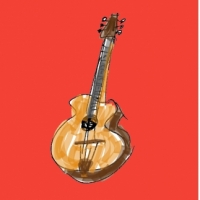DjangoBooks.com
Welcome to our Community!
Categories
- 20K All Categories
- 1.1K General
- 476 Welcome
- 59 Archtop Eddy's Corner
- 146 CD, DVD, and Concert Reviews
- 385 FAQ
- 26 Gypsy Jazz Italia
- 27 Photos
- 202 Gypsy Picking
- 21 Unaccompanied Django
- 15 Pearl Django Play-Along Vol.1
- 17 Gypsy Fire
- 45 Gypsy Rhythm
- 1.4K Gypsy Jazz University - Get Educated
- 131 Gypsy Jazz 101
- 227 Repertoire
- 219 History
- 708 Technique
- 51 Licks and Patterns
- 6 Daniel Givone Manouche Guitare Method Users Group
- 20 Eddie Lang Club
- 1.3K Gypsy Jazz Gear
- 802 Guitars, Strings, Picks, Amps, Pickups and Other Accessories
- 460 Classifieds
- 49 Recording
- 62 Other Instruments
- 18 Violin
- 5 Mandolin
- 22 Accordion
- 7 Bass
- 10 Woodwinds
- 347 Gypsy Jazz Events
- 143 North America
- 109 Europe
- 95 International
In this Discussion
Who's Online (0)
More information about an oud and it's maker
Hello,
I purchased this plain and unpretentious instrument last sunday, after having sold several instruments and gear I don't play any more on the music flea market the day before (amp, electric lap steel guitar, cornet, baritone uke, mini banjo ...).
The seller told me that it was built in Syria in the 1990s, the label says Ali Khalifeh & sons. As far as I know from scrolling through the web, they have been predecessors to Zeryab - whose ouds look totally different from mine, and maybe are not of any quality. Can anybody tell somtething about this special model, and what are the vital data of master Khalifeh and the other luthiers in the family?
I posted my questions here: https://www.mikeouds.com/messageboard/viewthread.php?tid=19385, but did not receive any response until now. So I dare to post again here, hoping that all the experts for any stringed thing lingering around will know more.
Thank you in advance for answering!
Willie














Comments
Better pics:
Hi Willie
I am not sure if this oud would date to the 90's but it is typical in appearance for ouds of that time period coming out of the Syrian region. Khalifeh & Sons ouds, much like Zeryab, vary quite a bit, many of them you find online are not so great but your oud looks well built. This oud would typically be tuned C-c (or a bit lower) as is typical for Arabic ouds. If you're new to ouds I'd recommend changing strings unless the seller had recently changed them. Strings make a big difference on ouds.
Also someone will probably reply to you on Mike's forum but it may take a little while. It's a slow moving forum but the only English friendly one that I'm aware of. Most of the oud discussion online is on Turkish language forums and scattered Facebook groups.
Willie,
Judging by some of the names of your students on the pictures you've shown in the past and knowing some of the demographics of Germany, I'm guessing you could find someone who speaks Turkish that could help you on one of those forums. Besides, English language instruction is fairly widespread in schools at least in the larger metropolitan areas of Turkey. I'm guessing if you posted something in English (or German), there might be a Turkish oud player that could help you out. Worth a shot if you really want to know.
Hi Jason, thank you for answering! Yes, I'm new to Oud. Interested for a long time, but no friend of highly ornamented instruments, so this special oud finally caught my attention. Sounds pretty good; according to the seller, the strings are 4 months old. And he told me that he did not play much because of his three months old little daughter.
Tuning is C -c , as you said.
I started playing little phrases, short melodies and exercises, finding out that this helps me to transport the rest stroke to the guitar. The different kind of plectrum allows my hand and wrist to avoid bad habits, and develop better ones.
The oud forum indeed seems to be slow moving, just a hand full of posts since monday.
Are you playing oud?
Yes I've played oud for many years. Never as my primary instrument but I do play regularly. Funny enough I played oud before starting with Gypsy jazz and found the right hand technique translates very well so I assume going in the other direction will also work well.
Right hand technique tends to vary a bit by region, you'll often see players from Palestine like Simon Shaheen almost wrap their arm around the back of the instrument instead of coming over the top of it like a guitar. Much like Selmer style guitars playing fairly close to the bridge usually yields the best tone and tighter articulation.
In another parallel to GJ I think you'll find different risha (mizrap in Turkish) materials/thicknesses make a big difference in how the right hand feels. I usually prefer buffalo horn or synthetic tortoise shell plectrums. Traditionally Arabic ouds were played with plectrums made from the quill of large feathers.
@billyshakes You are right, many of our pupils have turkish or arab roots, some of our teachers too. I certainly will have every help I need for translation work nearby.
@JasonS the young man who sold the oud showed me his picking position: over pickguard, not centered but nearer to the bridge. I am experimenting with several picks, finding the more flexible ones easier to play, but the harder ones better sounding ...
Remains of glue inside the soundhole, there must have been a rosette. So I think the oud looked more like that back then:
It's not uncommon for rosettes to break or fall out over time, they tend to be pretty fragile as you'd expect. A big single soundhole without a rosette is something you do see w/ Syrian ouds though. I like how rosettes look but you will be thankful it's not there if you ever need to work on the oud.
If you can get your hand in the soundhole you might find a wing nut on the neck block, if you ever need to remove or adjust the neck that's how you do it. Just be aware necks are often glued as well, it just depends on how the maker decided to do it.
With the strings attached my finger can only feel a brace near the soundhole.
Wing nut on oud: http://www.mikeouds.com/messageboard/viewthread.php?tid=8036
Truss rod on oud: http://www.mikeouds.com/messageboard/viewthread.php?tid=13195